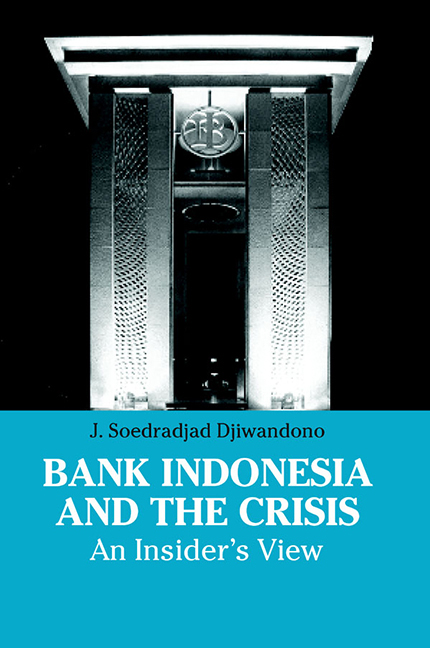Book contents
- Frontmatter
- Dedication
- Contents
- List of Tables
- Acknowledgements
- Glossary
- Prologue: The Crisis and Me
- 1 Introduction
- 2 Origin of the Crisis and Early Responses
- 3 Stabilization and Reform Programmes
- 4 Poor Programme Implementation
- 5 Stronger Programme with Weak Commitment
- 6 Bank Indonesia and the Crisis
- 7 Lessons from the Crisis
- 8 Epilogue
- Postscript
- Notes
- References
- Index
- About the Author
3 - Stabilization and Reform Programmes
Published online by Cambridge University Press: 21 October 2015
- Frontmatter
- Dedication
- Contents
- List of Tables
- Acknowledgements
- Glossary
- Prologue: The Crisis and Me
- 1 Introduction
- 2 Origin of the Crisis and Early Responses
- 3 Stabilization and Reform Programmes
- 4 Poor Programme Implementation
- 5 Stronger Programme with Weak Commitment
- 6 Bank Indonesia and the Crisis
- 7 Lessons from the Crisis
- 8 Epilogue
- Postscript
- Notes
- References
- Index
- About the Author
Summary
IMF — Supported Programmes
By formally receiving a stand-by loan from the IMF, the government's efforts to address the crisis entered a new phase. The programme was very comprehensive, and supported by the Fund. The government policy became a macroeconomic adjustment programme to deal with balance of payments disturbances, which reflected imbalances in the national economy.
The IMF functions like a credit union, whereby member countries borrow from it by using other member countries' funds. On the other hand, the IMF also simultaneously plays the role of lender of last resort, providing member countries with international liquidity in times of need.
The rest could only be drawn with conditions. This would be the part that has the characteristic of a loan, not a facility. The fund is taken from the general resource account (GRA) of IMF, and interest rates are not subsidized. This can only be drawn in stages, depending on the compliance of the borrowing country with respect to the conditionality. If the member country fails to fulfil part or the whole of the conditionality, the country will be denied from withdrawing the remaining amount of the loan. However, sometimes the stand-by loan is also called a facility. I will be using these terms interchangeably.
The phasing of the loan on top of the credit tranche can be in accordance with the needs of the receiving country. It could be initially large and subsequently smaller front-loading, or the reverse of it, with a large disbursement in the later period and less in the early part (back-loading).
Technically speaking, the actual IMF facilities are IMF loans not funded from the member countries' contributions. The funds are, for example, from the sale of IMF gold. These facilities usually bear subsidized interest rates. The single most important facility is the loan to assist highly indebted poor countries (HIPC) in the form of an enhanced structural adjustment facility (ESAF). In 1999 this facility was transformed into a new facility, called poverty reduction and growth facility (PRGF).
- Type
- Chapter
- Information
- Bank Indonesia and the CrisisAn Insider's View, pp. 76 - 107Publisher: ISEAS–Yusof Ishak InstitutePrint publication year: 2005



